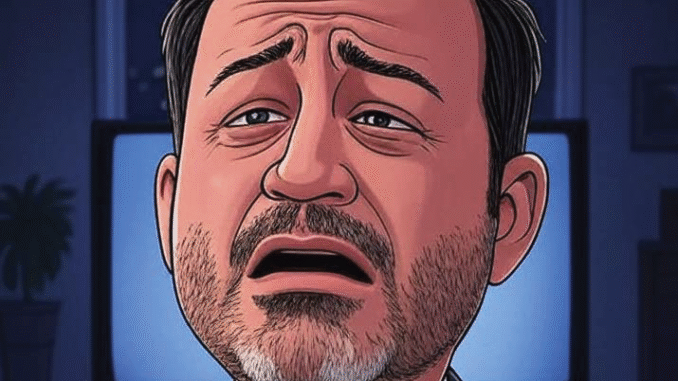
By Dan Cirucci
Cross-Posted from DanCirucci.com
For decades, late-night talk shows were the crown jewels of American television. With their blend of comedy monologues, celebrity interviews, music and pop culture broadsides, programs like The Tonight Show and The Late Show drew millions of viewers nightly, shaping national conversations and creating household names of their hosts. Indeed, Johnny Carson and Jay Leno once commanded audiences so large that they seemed unshakable.
But late-night TV degraded itself when it opened the door to what turned out to be dreary, insufferably partisan political commentary by the likes of Kimmel and Colbert, both of whom are unfunny and both of whom have now been canned.
The likes of Colbert and Kimmel only seemed to hasten a trend as late-night network television began to rapidly lose much of its former power, with viewership steadily eroding. Instead of reviving late night TV, Kimmel and Colbert effectively suffocated it.
Of course, it’s worth noting that late night TV’s decline is not only a story about changing hosts but also about insensitive and clueless programming as well as the fragmentation of media, shifting demographics, and the changing habits of audiences.
For one thing, people don’t stay up late anymore. They’re more likely to go to bed earlier and arise earlier. They want to get a jump on their workday. They work hard, they’re busy and their schedules are full. This would account for the rapid success of a show like Gutfeld which airs earlier in the evening, and for the success of early morning talk TV shows which have been airing earlier in the AM than ever before.
The Carson Era: Television’s Golden Standard
Johnny Carson, who helmed The Tonight Show from 1962 until 1992, embodied the peak of late-night television. During the 1986–87 season, Carson averaged over 6 million nightly viewers, with some estimates suggesting peaks as high as 17 million in the late 1970s. These numbers reflected a media environment with limited options: only a handful of networks existed, cable television was in its infancy, and there were no streaming services or online platforms to compete for attention. And this, too: Carson was actually funny. On the air, he was playful, quick witted and highly entertaining, managing to accomplish all this without ever taking himself seriously. In fact, he was as inclined to poke fun at himself as he was to mock others. Johnny idolized the comedy greats of yesteryear like Jack Benny and always thought of himself as a comedian first. Watch what Johnny had to say about this:
This is why Johnny Carson is THE iconic late-night talk show host:
“Why do they think that just because you have a Tonight Show that you must deal in serious issues? It’s a danger. It’s a real danger. Once you start that, you start to get that self-important feeling that what… pic.twitter.com/GQDg26eFrL
— Laura Powell (@LauraPowellEsq) September 18, 2025
Leno and Letterman: Competition at the Top
When Carson retired, Jay Leno and David Letterman took the reins of late-night. Both men carried forward the tradition of drawing millions of nightly viewers. Through the 1990s and early 2000s, Leno’s Tonight Show regularly pulled in between 5 and 6 million viewers. Letterman, while typically trailing Leno, still commanded strong audiences in the 4–5 million range. The rivalry between the two kept late-night relevant and entertaining, and both men remained fixtures of popular culture.
Even in his final years, Leno’s farewell episode in 2014 drew a massive 14.6 million viewers, a reminder of the power late-night TV could still wield under the right circumstances. Leno mostly followed the Carson mantra: no partisan politics; keep it funny and poke good humored fun at all comers. For his part, Letterman became crankier and more political is his later years, and his ratings dropped accordingly.
The Colbert, Fallon, and Kimmel Years: Decline Accelerates
The 2010s ushered in a new era of late-night hosts: Stephen Colbert on CBS, Jimmy Fallon on NBC, and Jimmy Kimmel on ABC. Initially, there was optimism that this new generation would sustain or even grow the audience. But Colbert came from a background of acerbic, sometimes mean-spirited, snarky political commentary posing as comedy a la Jon Stewart. Yes, Colbert saw a brief surge in 2016/2017, but even then he only averaged about 3.2 million nightly viewers at his peak. Still, Colbert’s ratings bump encouraged the other two (particularly Kimmel) to follow his petulant lead. Instead of innovating, Colbert’s late night rivals mostly imitated. So, Fallon and Kimmel who likewise hovered between 2 and 3 million during their strongest years, saw their audience begin to slide even further. Ratings wise, all three paled in comparison to their predecessors.
By 2020, Colbert’s average had fallen closer to 2.4 million, while Fallon and Kimmel dipped below 2 million. By 2024 and into 2025, Colbert was averaging around 1.9 million, Fallon about 1.5 million, and Kimmel roughly 1.6 million. This decline is particularly stark when contrasted with Carson’s 6–8 million or Leno’s 5–6 million averages. The trajectory was unmistakable: late-night talk shows, once central to American cultural life, were now drawing only a fraction of their former audiences.
Also, the shows lost money for their networks because they simply could not attract the advertising dollars they needed to sustain profitability. The audiences dwindled, the shows got more expensive and the advertising dollars dried up.
Of course, fragmentation of media has splintered audiences. Cable television, once a modest competitor, expanded in the 1990s. Then came streaming platforms like Netflix, Hulu, and Disney+, as well as on-demand viewing on YouTube and TikTok. Viewers, especially younger demographics, no longer need to wait until 11:30 p.m. to watch comedy—they can consume bite-sized sketches, monologues, and interviews on their own schedule.
_
Dan Cirucci, the founder and editor-in chief of The Dan Cirucci Blog, is one of the most widely honored public relations professionals in his field and a public relations consultant to numerous organizations and individuals.



